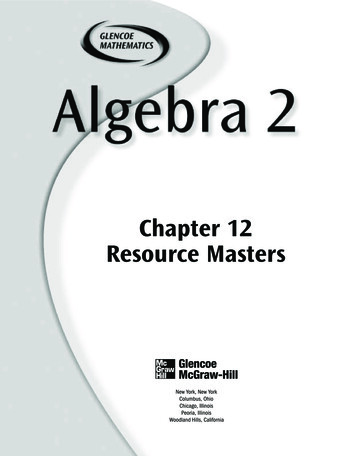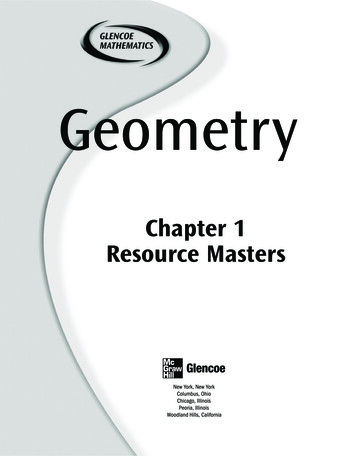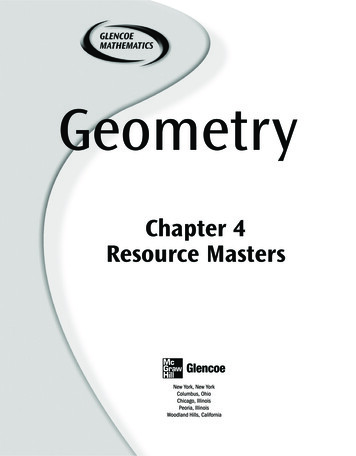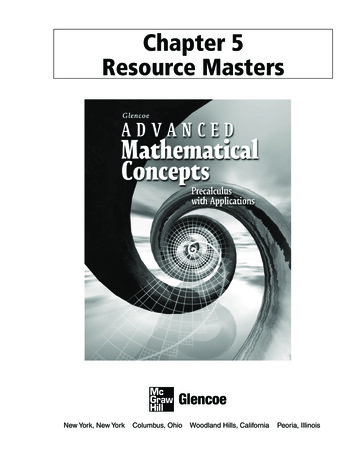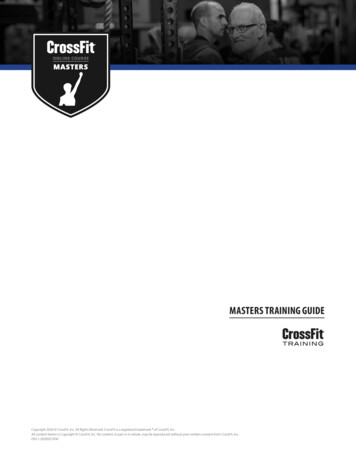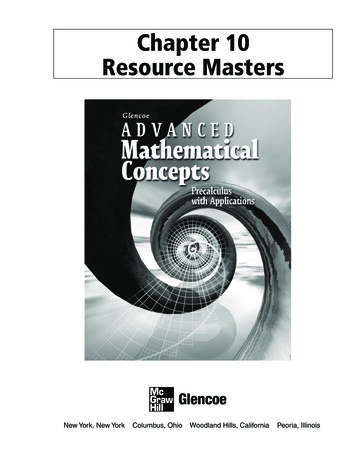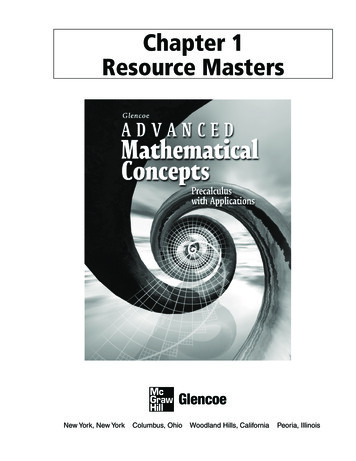
Transcription
Chapter 1Resource MastersNew York, New YorkColumbus, OhioWoodland Hills, CaliforniaPeoria, Illinois
StudentWorksTM This CD-ROM includes the entire Student Edition along with theStudy Guide, Practice, and Enrichment masters.TeacherWorksTM All of the materials found in this booklet are included for viewingand printing in the Advanced Mathematical Concepts TeacherWorksCD-ROM.Copyright The McGraw-Hill Companies, Inc. All rights reserved.Printed in the United States of America. Permission is granted to reproduce thematerial contained herein on the condition that such material be reproduced onlyfor classroom use; be provided to students, teachers, and families without charge;and be used solely in conjunction with Glencoe Advanced Mathematical Concepts.Any other reproduction, for use or sale, is prohibited without prior writtenpermission of the publisher.Send all inquiries to:Glencoe/McGraw-Hill8787 Orion PlaceColumbus, OH 43240-4027ISBN: 0-07-868229-01 2 3 4 5 6 7 8 9 10Advanced Mathematical ConceptsChapter 1 Resource MastersXXX13 12 11 10 09 08 07 06
ContentsVocabulary Builder . . . . . . . . . . . . . . . . . vii-xLesson 1-7Study Guide . . . . . . . . . . . . . . . . . . . . . . . . . . 19Practice . . . . . . . . . . . . . . . . . . . . . . . . . . . . . . 20Enrichment . . . . . . . . . . . . . . . . . . . . . . . . . . . 21Lesson 1-1Study Guide . . . . . . . . . . . . . . . . . . . . . . . . . . . 1Practice . . . . . . . . . . . . . . . . . . . . . . . . . . . . . . . 2Enrichment . . . . . . . . . . . . . . . . . . . . . . . . . . . . 3Lesson 1-8Study Guide . . . . . . . . . . . . . . . . . . . . . . . . . . 22Practice . . . . . . . . . . . . . . . . . . . . . . . . . . . . . . 23Enrichment . . . . . . . . . . . . . . . . . . . . . . . . . . . 24Lesson 1-2Study Guide . . . . . . . . . . . . . . . . . . . . . . . . . . . 4Practice . . . . . . . . . . . . . . . . . . . . . . . . . . . . . . . 5Enrichment . . . . . . . . . . . . . . . . . . . . . . . . . . . . 6Chapter 1 AssessmentChapter 1 Test, Form 1A . . . . . . . . . . . . . . 25-26Chapter 1 Test, Form 1B . . . . . . . . . . . . . . 27-28Chapter 1 Test, Form 1C . . . . . . . . . . . . . . 29-30Chapter 1 Test, Form 2A . . . . . . . . . . . . . . 31-32Chapter 1 Test, Form 2B . . . . . . . . . . . . . . 33-34Chapter 1 Test, Form 2C . . . . . . . . . . . . . . 35-36Chapter 1 Extended ResponseAssessment . . . . . . . . . . . . . . . . . . . . . . . . 37Chapter 1 Mid-Chapter Test . . . . . . . . . . . . . . 38Chapter 1 Quizzes A & B . . . . . . . . . . . . . . . . 39Chapter 1 Quizzes C & D. . . . . . . . . . . . . . . . 40Chapter 1 SAT and ACT Practice . . . . . . . 41-42Chapter 1 Cumulative Review . . . . . . . . . . . . 43Lesson 1-3Study Guide . . . . . . . . . . . . . . . . . . . . . . . . . . . 7Practice . . . . . . . . . . . . . . . . . . . . . . . . . . . . . . . 8Enrichment . . . . . . . . . . . . . . . . . . . . . . . . . . . . 9Lesson 1-4Study Guide . . . . . . . . . . . . . . . . . . . . . . . . . . 10Practice . . . . . . . . . . . . . . . . . . . . . . . . . . . . . . 11Enrichment . . . . . . . . . . . . . . . . . . . . . . . . . . . 12Lesson 1-5Study Guide . . . . . . . . . . . . . . . . . . . . . . . . . . 13Practice . . . . . . . . . . . . . . . . . . . . . . . . . . . . . . 14Enrichment . . . . . . . . . . . . . . . . . . . . . . . . . . . 15SAT and ACT Practice Answer Sheet,10 Questions . . . . . . . . . . . . . . . . . . . . . . . A1SAT and ACT Practice Answer Sheet,20 Questions . . . . . . . . . . . . . . . . . . . . . . . A2ANSWERS . . . . . . . . . . . . . . . . . . . . . . A3-A17Lesson 1-6Study Guide . . . . . . . . . . . . . . . . . . . . . . . . . . 16Practice . . . . . . . . . . . . . . . . . . . . . . . . . . . . . . 17Enrichment . . . . . . . . . . . . . . . . . . . . . . . . . . . 18 Glencoe/McGraw-HilliiiAdvanced Mathematical Concepts
A Teacher’s Guide to Using theChapter 1 Resource MastersThe Fast File Chapter Resource system allows you to conveniently file theresources you use most often. The Chapter 1 Resource Masters include the corematerials needed for Chapter 1. These materials include worksheets, extensions,and assessment options. The answers for these pages appear at the back of thisbooklet.All of the materials found in this booklet are included for viewing and printing inthe Advanced Mathematical Concepts TeacherWorks CD-ROM.Vocabulary Builder Pages vii-x include aPractice There is one master for each lesson.student study tool that presents the keyvocabulary terms from the chapter. Students areto record definitions and/or examples for eachterm. You may suggest that students highlight orstar the terms with which they are not familiar.These problems more closely follow thestructure of the Practice section of the StudentEdition exercises. These exercises are ofaverage difficulty.When to Use These provide additionalpractice options or may be used as homeworkfor second day teaching of the lesson.When to Use Give these pages to studentsbefore beginning Lesson 1-1. Remind them toadd definitions and examples as they completeeach lesson.Enrichment There is one master for eachlesson. These activities may extend the conceptsin the lesson, offer a historical or multiculturallook at the concepts, or widen students’perspectives on the mathematics they arelearning. These are not written exclusivelyfor honors students, but are accessible for usewith all levels of students.Study Guide There is one Study Guidemaster for each lesson.When to Use Use these masters asreteaching activities for students who needadditional reinforcement. These pages can alsobe used in conjunction with the Student Editionas an instructional tool for those students whohave been absent. Glencoe/McGraw-HillWhen to Use These may be used as extracredit, short-term projects, or as activities fordays when class periods are shortened.ivAdvanced Mathematical Concepts
Assessment OptionsIntermediate AssessmentThe assessment section of the Chapter 1Resources Masters offers a wide range ofassessment tools for intermediate and finalassessment. The following lists describe eachassessment master and its intended use.Chapter Tests Forms 1A, 1B, and 1C Form 1 tests containmultiple-choice questions. Form 1A isintended for use with honors-level students,Form 1B is intended for use with averagelevel students, and Form 1C is intended foruse with basic-level students. These tests aresimilar in format to offer comparable testingsituations.Forms 2A, 2B, and 2C Form 2 tests arecomposed of free-response questions. Form2A is intended for use with honors-levelstudents, Form 2B is intended for use withaverage-level students, and Form 2C isintended for use with basic-level students.These tests are similar in format to offercomparable testing situations.The Extended Response Assessmentincludes performance assessment tasks thatare suitable for all students. A scoring rubricis included for evaluation guidelines.Sample answers are provided forassessment. Glencoe/McGraw-Hill Four free-response quizzes are included tooffer assessment at appropriate intervals inthe chapter. The SAT and ACT Practice offerscontinuing review of concepts in variousformats, which may appear on standardizedtests that they may encounter. This practiceincludes multiple-choice, quantitativecomparison, and grid-in questions. Bubblein and grid-in answer sections are providedon the master. The Cumulative Review provides studentsan opportunity to reinforce and retain skillsas they proceed through their study ofadvanced mathematics. It can also be usedas a test. The master includes free-responsequestions.AnswersAll of the above tests include a challengingBonus question. A Mid-Chapter Test provides an option toassess the first half of the chapter. It iscomposed of free-response questions.Continuing AssessmentChapter Assessments v Page A1 is an answer sheet for the SAT andACT Practice questions that appear in theStudent Edition on page 65. Page A2 is ananswer sheet for the SAT and ACT Practicemaster. These improve students’ familiaritywith the answer formats they may encounterin test taking. The answers for the lesson-by-lessonmasters are provided as reduced pages withanswers appearing in red. Full-size answer keys are provided for theassessment options in this booklet.Advanced Mathematical Concepts
Chapter 1 Leveled WorksheetsGlencoe’s leveled worksheets are helpful for meeting the needs of everystudent in a variety of ways. These worksheets, many of which are foundin the FAST FILE Chapter Resource Masters, are shown in the chartbelow. Study Guide masters provide worked-out examples as well as practiceproblems. Each chapter’s Vocabulary Builder master provides students theopportunity to write out key concepts and definitions in their ownwords. Practice masters provide average-level problems for students whoare moving at a regular pace. Enrichment masters offer students the opportunity to extend theirlearning.Five Different Options to Meet the Needs ofEvery Student in a Variety of Waysprimarily skillsprimarily conceptsprimarily applicationsBASICAVERAGE1Study Guide2Vocabulary Builder3Parent and Student Study Guide (online) dvanced Mathematical Concepts
NAME DATE PERIODChapterReading to Learn Mathematics1Vocabulary BuilderThis is an alphabetical list of the key vocabulary terms you will learn in Chapter 1.As you study the chapter, complete each term’s definition or description.Remember to add the page number where you found the term.Vocabulary TermFoundon PageDefinition/Description/Exampleabscissaabsolute value functionbest-fit lineboundarycoinciding linescompositecomposition of functionsconstant functioncorrelation coefficientdomain(continued on the next page) Glencoe/McGraw-HillviiAdvanced Mathematical Concepts
NAME DATE PERIODChapter1Reading to Learn MathematicsVocabulary Builder (continued)Vocabulary TermFoundon PageDefinition/Description/Examplefamily of graphsfunctionfunction notationgoodness of fitgreatest integer functionhalf planeiterateiterationlinear equationlinear functionlinear inequality(continued on the next page) Glencoe/McGraw-HillviiiAdvanced Mathematical Concepts
NAME DATE PERIODChapter1Reading to Learn MathematicsVocabulary Builder (continued)Vocabulary TermFoundon allel linesPearson-product momentcorrelationperpendicular linespiecewise functionpoint-slope formprediction equationrangeregression linerelation(continued on the next page) Glencoe/McGraw-HillixAdvanced Mathematical Concepts
NAME DATE PERIODChapter1Reading to Learn MathematicsVocabulary Builder (continued)Vocabulary TermFoundon PageDefinition/Description/Examplescatter plotslopeslope intercept formstandard formstep functionvertical line testx-intercepty-interceptzero of a function Glencoe/McGraw-HillxAdvanced Mathematical Concepts
NAME DATE PERIOD1-1Study GuideRelations and FunctionsA relation is a set of ordered pairs. The set of first elementsin the ordered pairs is the domain, while the set of secondelements is the range.Example 1State the domain and range of the following relation.{(5, 2), (30, 8), (15, 3), (17, 6), (14, 9)}Domain: {5, 14, 15, 17, 30}Range: {2, 3, 6, 8, 9}You can also use a table, a graph, or a rule torepresent a relation.Example 2The domain of a relation is all odd positive integersless than 9. The range y of the relation is 3 more than x,where x is a member of the domain. Write the relationas a table of values and as an equation. Then graph therelation.Table:Equation:Graph:y x 3xy143658710A function is a relation in which each element of the domain ispaired with exactly one element in the range.Example 3State the domain and range of each relation. Thenstate whether the relation is a function.a. {( 2, 1), (3, 1), (2, 0)}The domain is { 2, 2, 3} and the range is { 1, 0, 1}. Eachelement of the domain is paired with exactly oneelement of the range, so this relation is a function.b. {(3, 1), (3, 2), (9, 1)}The domain is {3, 9}, and the range is { 2, 1, 1}. In thedomain, 3 is paired with two elements in the range, 1and 2. Therefore, this relation is not a function.Example 4Evaluate each function for the given value.a. ƒ( 1) if ƒ(x) 2x3 4x2 5xƒ( 1) 2( 1)3 4( 1)2 5( 1) x 1 2 4 5 or 7b. g(4) if g(x) x4 3x2 4g(4) (4)4 3(4)2 4 x 4 256 48 4 or 212 Glencoe/McGraw-Hill1Advanced Mathematical Concepts
NAME DATE PERIOD1-1PracticeRelations and FunctionsState the domain and range of each relation. Then state whetherthe relation is a function. Write yes or no.1. {( 1, 2), (3, 10), ( 2, 20), (3, 11)}2. {(0, 2), (13, 6), (2, 2), (3, 1)}4. {( 1, 2), (3, 54), ( 2, 16), (3, 81)}3. {(1, 4), (2, 8), (3, 24)}5. The domain of a relation is all evennegative integers greater than 9.The range y of the relation is the setformed by adding 4 to the numbersin the domain. Write the relation asa table of values and as an equation.Then graph the relation.Evaluate each function for the given value.7. ƒ(3) if ƒ(x) 5x2 4x 66. ƒ( 2) if ƒ(x) 4x3 6x2 3x8. h(t) if h(x) 9x9 4x4 3x 29. ƒ(g 1) if ƒ(x) x2 2x 110. Climate The table shows record high andlow temperatures for selected states.a. State the relation of the data as a set ofordered pairs.b. State the domain and rangeof the relation.Record High and Low Temperatures ( F)StateHighLowAlabama112 27Delaware110 17Idaho118 60Michigan112 51New Mexico122 50Wisconsin114 54Source: National Climatic Data Centerc. Determine whether the relation is a function. Glencoe/McGraw-Hill2Advanced Mathematical Concepts
NAME DATE PERIOD1-1EnrichmentRates of ChangeBetween x a and x b, the function f (x) changes by f (b) f (a).The average rate of change of f (x) between x a and x b is definedby the expressionf (b) f (a) (b a).Find the change and the average rate of change of f(x) in the given range.1. f (x) 3x 4, from x 3 to x 82. f (x) x 2 6x 10, from x 2 to x 4The average rate of change of a function f (x) over aninterval is the amount the function changes per unitchange in x. As shown in the figure at the right, theaverage rate of change between x a and x brepresents the slope of the line passing through thetwo points on the graph of f with abscissas a and b.3. Which is larger, the average rate of change off (x) x 2 between 0 and 1 or between 4 and 5?4. Which of these functions has the greatest average rate of changebetween 2 and 3: f (x) x ; g(x) x 2; h(x) x 3 ?5. Find the average rate of change for the function f (x) x 2 in each interval.a. a 1 to b 1.1b. a 1 to b 1.01c. a 1 to b 1.001d. What value does the average rate of change appear to beapproaching as the value of b gets closer and closer to 1?The value you found in Exercise 5d is the instantaneous rate ofchange of the function. Instantaneous rate of change has enormousimportance in calculus, the topic of Chapter 15.6. Find the instantaneous rate of change of the function f (x) 3x 2as x approaches 3. Glencoe/McGraw-Hill3Advanced Mathematical Concepts
NAME DATE PERIOD1-2Study GuideComposition of FunctionsOperations of Two functions can be added together, subtracted,Functionsmultiplied, or divided to form a new function.Example 1Given ƒ(x) x2 x 6 and g(x) x 2, find eachfunction.a. (ƒ g)(x)( ƒ g)(x) ƒ(x) g(x) x2 x 6 x 2 x2 4b. (ƒ g)(x)( ƒ g)(x) ƒ(x) g(x) x2 x 6 (x 2) x2 2x 8c. ( ƒ g)(x)( ƒ g)(x) ƒ(x) g(x) (x2 x 6)(x 2) x3 x2 8x 12d. (x)g ƒ( x)ƒ g (x) g( x)ƒx x 6 x 22(x 3)(x 2) x 2 x 3, x 2Functions can also be combined by using composition. Thefunction formed by composing two functions ƒ and g is calledthe composite of ƒ and g, and is denoted by ƒ g. [ƒ g](x) isfound by substituting g(x) for x in ƒ(x).Example 2Given ƒ(x) 3x2 2x 1 and g(x) 4x 2,find [ƒ g](x) and [g ƒ](x).[ ƒ g](x) ƒ(g(x)) ƒ(4x 2)Substitute 4x 2 for g(x).2 3(4x 2) 2(4x 2) 1 Substitute 4x 2 for x in ƒ(x). 3(16x2 16x 4) 8x 4 1 48x2 56x 15[ g ƒ](x) g( ƒ(x)) g(3x2 2x 1)Substitute 3x2 2x 1 for ƒ(x). 4(3x2 2x 1) 2 Substitute 3x2 2x 1 for x in g(x). 12x2 8x 2 Glencoe/McGraw-Hill4Advanced Mathematical Concepts
NAME DATE PERIOD1-2PracticeComposition of FunctionsGiven ƒ(x) 2x2 8 and g(x) 5x 6, find each function.1. ( ƒ g)(x)2. ( ƒ g)(x) ƒ3. ( ƒ g)(x)4. g (x)Find [ƒ g](x) and [g ƒ](x) for each ƒ(x) and g(x).5. ƒ(x) x 56. ƒ(x) 2x3 3x2 1g(x) x 3g(x) 3x7. ƒ(x) 2x2 5x 1g(x) 2x 38. ƒ(x) 3x2 2x 5g(x) 2x 1 2 and g(x) 3x.9. State the domain of [ ƒ g](x) for ƒ(x) xFind the first three iterates of each function using the giveninitial value.11. ƒ(x) x2 1; x0 210. ƒ(x) 2x 6; x0 112. Fitness Tara has decided to start a walking program. Herinitial walking time is 5 minutes. She plans to double herwalking time and add 1 minute every 5 days. Provided thatTara achieves her goal, how many minutes will she be walkingon days 21 through 25? Glencoe/McGraw-Hill5Advanced Mathematical Concepts
NAME DATE PERIOD1-2EnrichmentApplying Composition of FunctionsBecause the area of a square A is explicitly determined by the lengthof a side of the square, the area can be expressed as a function of onevariable, the length of a side s: A f (s) s2. Physical quantities areoften functions of numerous variables, each of which may itself be afunction of several additional variables. A car’s gas mileage, forexample, is a function of the mass of the car, the type of gasolinebeing used, the condition of the engine, and many other factors, eachof which is further dependent on other factors. Finding the value ofsuch a quantity for specific values of the variables is often easiest byfirst finding a single function composed of all the functions and thensubstituting for the variables.The frequency f of a pendulum is the number of complete swings thependulum makes in 60 seconds. It is a function of the period p of thependulum, the number of seconds the pendulum requires to60make one complete swing: f ( p) p .In turn, the period of a pendulum is a function of its length L in .centimeters: p(L) 0.2 LFinally, the length of a pendulum is a function of its length at 0 Celsius, the Celsius temperature C, and the coefficient of expansion eof the material of which the pendulum is made:L( , C, e) (1 eC).1. a. Find and simplify f( p(L( , C, e))), an expression for thefrequency of a brass pendulum, e 0.00002, in terms of itslength, in centimeters at 0 C, and the Celsius temperature.b. Find the frequency, to the nearest tenth, of a brass pendulumat 300 C if the pendulum’s length at 0 C is 15 centimeters.2. The volume V of a spherical weather balloon with radius r isgiven by V(r) 4 r 3. The 3balloon is being inflated so that the1radius increases at a constant rate r(t) 2 t 2, where r is inmeters and t is the number of seconds since inflation began.a. Find V(r(t))b. Find the volume after 10 seconds of inflation. Use 3.14 for . Glencoe/McGraw-Hill6Advanced Mathematical Concepts
NAME DATE PERIOD1-3Study GuideGraphing Linear EquationsYou can graph a linear equation Ax By C 0, where Aand B are not both zero, by using the x- and y-intercepts. To findthe x-intercept, let y 0. To find the y-intercept, let x 0.Example 1Graph 4x y 3 0 using the x- and y-intercepts.Substitute 0 for y to find the x-intercept. Thensubstitute 0 for x to find the y-intercept.x-intercept4x y 3 04x 0 3 04x 3 04x 3x 34 y-intercept4x y 3 04(0) y 3 0y 3 0y 3 The line crosses the x-axis at 34 , 0 and the y-axis at (0, 3).Graph the intercepts and draw the line that passes throughthem.The slope of a nonvertical line is the ratio of the change inthe y-coordinates of two points to the corresponding change inthe x-coordinates of the same points. The slope of a line can beinterpreted as the ratio of change in the y-coordinates to thechange in the x-coordinates.SlopeThe slope m of a line through two points (x1, y1) and (x2, y2) is given byy2 y1 .m x2 x1Example 2Find the slope of the line passing throughA( 3, 5) and B(6, 2).y y21 m x x212 5 6 ( 3)Let x1 3, y1 5, x2 6, and y2 2. 3 or 1 93 Glencoe/McGraw-Hill7Advanced Mathematical Concepts
NAME DATE PERIOD1-3PracticeGraphing Linear EquationsGraph each equation using the x- and y-intercepts.1. 2x y 6 02. 4x 2y 8 0Graph each equation using the y-intercept and the slope.3. y 5x 12 4. y 12 xFind the zero of each function. Then graph the function.5. ƒ(x) 4x 36. ƒ(x) 2x 47. Business In 1990, a two-bedroom apartment at RemingtonSquare Apartments rented for 575 per month. In 1999, thesame two-bedroom apartment rented for 850 per month.Assuming a constant rate of increase, what will a tenant payfor a two-bedroom apartment at Remington Square in theyear 2000? Glencoe/McGraw-Hill8Advanced Mathematical Concepts
NAME DATE PERIOD1-3EnrichmentInverses and Symmetry1. Use the coordinate axes at the right to graph thefunction f(x) x and the points A(2, 4), A′(4, 2),B(–1, 3), B′(3, –1), C(0, –5), and C′(–5, 0).2. Describe the apparent relationship between thegraph of the function f(x) x and any two pointswith interchanged abscissas and ordinates.3. Graph the function f(x) 2x 4 and its inverse f –1(x) onthe coordinate axes at the right.4. Describe the apparent relationship between the graphsyou have drawn and the graph of the function f(x) x.Recall from your earlier math courses that two points P andQ are said to be symmetric about line provided that P andQ are equidistant from and on a perpendicular through .The line is the axis of symmetry and P and Q are images ofeach other in . The image of the point P(a, b) in the liney x is the point Q(b, a).5. Explain why the graphs of a function f (x) and its inverse, f –1 (x),are symmetric about the line y x . Glencoe/McGraw-Hill9Advanced Mathematical Concepts
NAME DATE PERIOD1-4Study GuideWriting Linear EquationsThe form in which you write an equation of a line dependson the information you are given. Given the slope andy-intercept, or given the slope and one point on the line, theslope-intercept form can be used to write the equation.Example 1Write an equation in slope-intercept form for each linedescribed.a. a slope of 23 and a y-intercept of 5Substitute 23 for m and 5 for b in the generalslope-intercept form.y mx b y 23 x 5.The slope-intercept form of the equation ofthe line is y 23 x 5.b. a slope of 4 and passes through the pointat ( 2, 3)Substitute the slope and coordinates of thepoint in the general slope-intercept form of alinear equation. Then solve for b.y mx b3 4( 2) bSubstitute 2 for x, 3 for y, and 4 for m.11 bAdd 8 to both sides of the equation.The y-intercept is 11. Thus, the equation for the line is y 4x 11.When you know the coordinates of two points on a line,you can find the slope of the line. Then the equation of theline can be written using either the slope-intercept or thepoint-slope form, which is y y1 m(x x1).Example 2Sales In 1998, the average weekly first-quartersales at Vic’s Hardware store were 9250. In 1999,the average weekly first-quarter sales were 10,100. Assuming a linear relationship, find theaverage quarterly rate of increase.(1, 9250) and (5, 10,100) Since there are two data points, identify the twoy2 y 1coordinates to find the slope of the line.m Coordinate 1 represents the first quarter of 1998x2 x1and coordinate 5 represents the first quarter of10,100 9250 5 11999.85 0 or 212.5 4Thus, for each quarter, the average sales increase was 212.50. Glencoe/McGraw-Hill10Advanced Mathematical Concepts
NAME DATE PERIOD1-4PracticeWriting Linear EquationsWrite an equation in slope-intercept form for each line described.1. slope 4, y-intercept 32. slope 5, passes through A( 3, 2)3. slope 4, passes through B(3, 8)4. slope 43 , passes through C( 9, 4)5. slope 1, passes through D( 6, 6)6. slope 1, passes through E(3, 3)7. slope 3, y-intercept 34 8. slope 2, y-intercept 79. slope 1, passes through F( 1, 7)10. slope 0, passes through G(3, 2)11. Aviation The number of active certified commercialpilots has been declining since 1980, as shown inthe table.a. Find a linear equation that can be used as a modelto predict the number of active certified commercialpilots for any year. Assume a steady rate of decline.b. Use the model to predict the number of pilots inthe year 2003. Glencoe/McGraw-Hill11Number of ActiveCertified 93143,0141994138,7281995133,9801996129,187Source: U. S. Dept.of TransportationAdvanced Mathematical Concepts
NAME DATE PERIOD1-4EnrichmentFinding Equations From AreaA right triangle in the first quadrant is bounded by thex-axis, the y-axis, and a line intersecting both axes. Thepoint (1, 2) lies on the hypotenuse of the triangle. Thearea of the triangle is 4 square units.Follow these instructions to find the equation of the line containingthe hypotenuse. Let m represent the slope of the line.1. Write the equation, in point-slope form, of the line containing thehypotenuse of the triangle.2. Find the x-intercept and the y-intercept of the line.3. Write the measures of the legs of the triangle.4. Use your answers to Exercise 3 and the formula for the area of atriangle to write an expression for the area of the triangle interms of the slope of the hypotenuse. Set the expression equal to4, the area of the triangle, and solve for m .5. Write the equation of the line, in point-slope form, containing thehypotenuse of the triangle.6. Another right triangle in the first quadrant has an area of4 square units. The point (2, 1) lies on the hypotenuse. Find theequation of the line, in point-slope form, containing thehypotenuse.7. A line with negative slope passes through the point (6, 1). Atriangle bounded by the line and the coordinate axes has an areaof 16 square units. Find the slope of the line. Glencoe/McGraw-Hill12Advanced Mathematical Concepts
NAME DATE PERIOD1-5Study GuideWriting Equations of Parallel and Perpendicular Lines Two nonvertical lines in a plane are parallel if and only iftheir slopes are equal and they have no points in common. Graphs of two equations that represent the same line aresaid to coincide. Two nonvertical lines in a plane are perpendicular if andonly if their slopes are negative reciprocals.Example 1Determine whether the graphs of each pair ofequations are parallel, coinciding, or neither.a. 2x 3y 5b. 12x 6y 186x 9y 214x 2y 6Write each pair of equations in slope-intercept form.a. 2x 3y 5y 23 x 53 6x 9y 21y 23 x 73 The lines have the same slopebut different y-intercepts, sothey are parallel.Example 2b. 12x 6y 18y 2x 34x 2y 6y 2x 3The equations are identical, so thelines coincide.Write the standard form of the equation of theline that passes through the point at (3, 4) andis parallel to the graph of x 3y 4 0.Any line parallel to the graph of x 3y 4 0will have the same slope. So, find the slope of thegraph of x 3y 4 0.A m B 13 A 1, B 3Use the point-slope form to write the equation ofthe line.y y1 m(x x1)y ( 4) 13 (x 3) x1 3, y1 4, m 13 y 4 13 x 13y 12 x 3x 3y 9 0 Glencoe/McGraw-HillMultiply each side by 3.Write in standard form.13Advanced Mathematical Concepts
NAME DATE PERIOD1-5PracticeWriting Equations of Parallel and Perpendicular LinesDetermine whether the graphs of each pair of equations areparallel, perpendicular, coinciding, or none of these.1. x 3y 182. 2x 4y 83x 9y 12x 2y 43. 3x 2y 62x 3y 124. x y 63x y 65. 4x 8y 22x 4y 86. 3x y 96x 2y 18Write the standard form of the equation of the line that is parallelto the graph of the given equation and that passes through thepoint with the given coordinates.7. 2x y 5 0; (0, 4)8. 3x y 3 0; ( 1, 2)9. 3x 2y 8 0; (2, 5)Write the standard form of the equation of the line that isperpendicular to the graph of the given equation and that passesthrough the point with the given coordinates.10. 2x y 6 0; (0, 3) 11. 2x 5y 6 0; ( 4, 2) 12. 3x 4y 13 0; (2, 7)13. Consumerism Marillia paid 180 for 3 video games and 4 books. Three monthslater she purchased 8 books and 6 video games. Her brother guessed that shespent 320. Assuming that the prices of video games and books did not change,is it possible that she spent 320 for the second set of purchases? Explain. Glencoe/McGraw-Hill14Advanced Mathematical Concepts
NAME DATE PERIOD1-5EnrichmentReading Mathematics: Question AssumptionsStudents at the elementary level assume that the statements intheir textbooks are complete and verifiably true. A lesson on the
and be used solely in conjunction with Glencoe Advanced Mathematical Concepts. Any other reproduction, for use or sale, is proh

